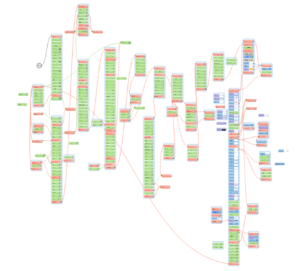You might have recently read quite a few articles summarising last year’s online marketing trends – but this article is not about summarising last year’s widely published and discussed news, but simply about what changes 2015 has brought to my professional life. Of course how someone sees this, heavily depends on what kind of marketing activities one pursues for clients and for own projects; therefore the below list will be neither objective nor definitive.
Facebook bigger than AdWords
While there are clients and there are certain kind of activities where it is still better to spend the vast majority of your budget on Google AdWords, but for me, 2015 was the first year when I was relying more on Facebook’s than Google’s advertising system. I have found myself spending my clients’ money more and more on Facebook and less and less on AdWords – even discontinuing advertising on Google Search for certain clients.
A few years ago AdWords was the one and only online ad system if you wanted to have a wide coverage and considerably grow your web site traffic by paid ads (I mean in Hungary and a handful of other markets outside the US), now it became just one – but still important – part of your marketing mix.
Facebook video bigger than YouTube
During the previous years, I just loved to advertise on YouTube with the TrueView video format: it was extremely cheap and fairly cost-effective. Last year it turned out that advertising with videos was even more effective on Facebook. I don’t mean here differences like the video autoplay function, but the fact that Facebook facilitates a way more intensive discussion related to the promoted videos. While on YouTube only a small fraction of viewers are commenting, on Facebook it turned out in many cases that prospects would frequently start meaningful, interesting, many times enthusiastic discussions as a consequence of video promotions.
Prospects asking their friend’s opinion, including their names in comments to notify them about a certain promoted content – isn’t this what many marketers would even die for? 🙂
A bigger mess to tidy up
AdWords, Facebook, plus add a few more contenders like LinkedIN, Instagram, Twitter – you will be quickly messing around with complex multi-channel online marketing campaigns, sometimes even for quite small clients with very straightforward business models. So things have been getting more complicated, so chances are getting higher that you’ll get lost somewhere.
This is the reason why I have been spending quite some time with properly naming my campaigns, remarketing lists, conversion points, events, etc. I had to set up sometimes quite a sophisticated naming conversions so that I could effectively work with many channels and many campaigns. And it was just one side effect of having to manage ad spendings on more online channels.
Google Tag Manager – a marketing dashboard
When defining complex marketing funnels with multiple steps and multiple channels, you will most likely end up with a quite complex Google Tag Manager setup – again with a well-thought-out naming convention system labelling the different tracking codes for the interactions you would like to measure along the entire online marketing funnel.
Therefore Google Tag Manager became one of the most important places where I can administer and overview the whole set up for complex online marketing activities – sometimes even incorporating additional logic a CMS system would never be able to handle. So far ”only” the results are missing from this interface.
Google Analytics just not enough
As an obvious consequence of our shift towards data-driven marketing, even the most sophisticated traditional web traffic analytics solutions seemed to be getting more and more obsolete, and lacking many People Analytics-related features of great importance. Even if I fed relevant data into Analytics to anonymously identify visitors, quickly found myself downloading a series of weekly data reports one by one so that I could get precise reports for a bigger time interval – instead of the heavily sampled ones, which proved to be a useless when I wanted to found a needle in the haystack.
On the other hand, the Google Analytics Premium is clearly a no-go for the majority of clients – both for its price tag and its missing features to easily identify individual leads’ activities.
Big Data bigger than Marketing
Having delved into Big Data and BI, in general, I got to a conclusion that while many principles and methods are indeed applicable to 99% of us online marketers, but for almost the same high percentage of us Big Data solutions are just an overkill – with a fairly big price tag.
I think just a small fraction of us would generate gigabytes of data per day with their marketing activities – so there should be a term like ”Medium-sized Data” coined for those online marketing professionals who would like to use complex systems to manage their data-driven marketing activities, without feeling forced to shell out a lot of money or hiring programmers for Big Data solutions that are eventually meant to handle huge data sets.
SEM more complex than SEO
At the beginning of this decade building up and running a complex system for my multilingual mass link building practice meant a much bigger intellectual challenge than I could ever imagine with paid search campaigns way back then. I think last year we got to the point where paid search and paid social media advertising together allowed us to create much more sophisticated processes and systems than the most complex search engine optimisation cases.
Managing various audiences – even beyond remarketing lists, see matching customers’ emails for instance – on multiple platforms proved to be more challenging for me than building links or content for getting better organic rankings.
Hosting is cheaper than ever
It might not be something last year brought to us, but I just realised it in 2015: I used to run the same virtual private server for more than nine years, just because I was too lazy to migrate all of the servers to a newer system or to an other VPS provider. But as the infrastructure of my old server was shut down without prior notice, I found myself forced to find an other hosting company – and ended up paying for the same service, four times less than before.
Other than that I could figure out how to host huge WordPress sites effectively on a bare minimum VPS setup. It was a long journey to find the best configuration, but the good news is that there is an almost-out-of-the-box solution for those who don’t want to pay the relatively high price of a managed WordPress hosting service but dare to mess around a little bit with Linux command line. WordPress is still not meant to host tens of thousands of posts, but you can find some workarounds to make that possible – without having to run it on a supercomputer.
…and a lot more
Of course last year I also started quite a few other new things – some of them will hopefully bear fruits this year, and some of them will define what and how I will work during this year. But one thing is for sure – we won’t be left being bored this year either…
Image credits – Photo by kazuend. Source: https://unsplash.com/photos/tVCu6V-IcSI



